As you can tell from my introduction, I'm trying to downplay expectations for the classics of times past. 2012 for the Nokia 808 PureView and 2013 for the Lumia 1020 are both half a decade away and tremendous progress has been made across the board since then in terms of sensor technology and, especially, in image processing.
Mind you, while newer is often better, the fact that it's taken that half decade for the Nokia classics to really get out-classed is testament to their class.
I'm also going to throw in a third classic, from 2014 and running Android, the Samsung Galaxy K Zoom, which features a genuine 10x optical zoom in the body of a phone - it's a stunning device that I really wish hadn't proved so unreliable and therefore dropped by Samsung in terms of development. Maybe such a large mechanical zoom really is a bad idea in a phone, which typically gets 100x the use of a standalone camera in terms of punishment and wear and tear?

Meaning that of the four phone cameras tested here for their zoom capabilities, three of them are 100% irrelevant in terms of a 2018 buying decision! But the demand for a comparison is still there, as you'll have read in numerous article comments, so here goes...
The methodology here was somewhat fluid, not least because of the differences in output resolution and zoom capability, but the idea in each test case was to get maximum detail and clarity on the chosen subject.
Why zoom in the first place? Usually because the subject can't be approached closely enough. For example, when you can't physically get close enough to a subject, usually at an event or attraction, with people or barriers in the way. Or perhaps something's up high? Or simply far away and you want a tighter cropped scene with the subject larger? Or perhaps you're shooting people and you could move closer, but then you'd intrude on the moment, so shooting from further away gives you fuller resolution with a tighter field of view.
But on with the tests. Because I'm comparing zoomed output from no less than four different smartphone cameras, I've adopted a grid of 1:1 crops approach, making it easy to compare the same subject detail from all four at the same time. Again, I can't emphasise enough that only one of the three phone cameras here is 'current' and that, in particular, the Samsung K Zoom is only here to show what a 'real' zoom can do.

As detailed in my guide to PureView zoom, the Nokia 808 and Lumia 1020 both zoom to around 2.5x in their default 5MP mode, while the S9+ zooms to 2x in good light using its telephoto lens, though at 9MP, which shouldn't be too far off what the Nokia units produce in terms of resolution. In low light, the Nokia pair maintain their lossless zoom, though the quality loss from not having oversampling is then more obvious.
The joker in the pack is the ultra-niche part-phone, part-camera K Zoom, which obviously goes up to 10x zoom even at its full 16MP resolution. And in most cases below I use it. Gulp. But don't take this data point too seriously - what most of you are interested in is how the S9+ zoom compares to the Nokia zoom champions of old!
Test 1: The Island
A good example of a subject which can't be approached for a closer shot. This little island is in the middle of my local park pond. Here's the overall (unzoomed, to give you a sense of the zooming and cropping used) scene:

You can grab the original test images from the Nokia 808, Nokia Lumia 1020, Samsung Galaxy S9+ and Galaxy K Zoom here, if you want to download them and do your own analysis.
And here are the promised detailed 1:1 crops from the zoomed shots, in sequence from 5MP at 2.5x zoom for the two Nokias (the top row), to 9MP at 2x zoom for the Galaxy S9+ and 10x for the K Zoom (the bottom row):




The first three crops are very comparable but serve as something of a lesson in how to do sharpening in a phone's image processing stack. The Nokia 808's rendition is super natural and probably 'purest', but the 1020 adds a tiny bit more detail (thanks to the newer sensor and - possibly - OIS), plus it also adds a little processing to the mix. The end result is my favourite in terms of the balance of detail and atmosphere. The S9+ produces similar detail, even in the much thinner form factor, thanks to the extra telephoto lens, but Samsung's processing goes too far, in my opinion, at least for natural detail like this - everything's too jagged, too artificial.
The now-ancient K Zoom, included here to show what a 'real' zoom can do, is of course in a different league. In good light, this is simply amazing. And remember, the K Zoom is/was still a full Android smartphone and no thicker than the Nokia 808. Interesting, anyway!
Test 2: The Duck(!)
Now, let's try a living subject that can't be approached closely. Enter a handily placed duck! Here's the overall (unzoomed) scene:

You can grab the original test images from the Nokia 808, Nokia Lumia 1020, Samsung Galaxy S9+ and Galaxy K Zoom here, if you want to download them and do your own analysis.
And here are the promised detailed 1:1 crops from the zoomed shots, in sequence from 5MP at 2.5x zoom for the two Nokias (the top row), to 9MP at 2x zoom for the Galaxy S9+ and 10x for the K Zoom (the bottom row):



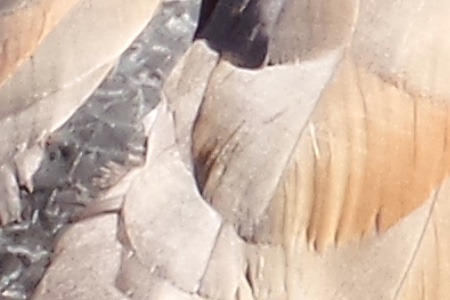
Again we see the progression in image processing. The effective maximum zoom is similar in each of the first three photos, but with the 808 super natural, the 1020 adding extra clarity and some sharpening, and the S9+ going all out for sharp edges, at the expense of (in this case) water not looking like water anymore.
Test 3: Daffodil
Staying with nature, but this time wanting some sharp edges and clarity. These daffodils are a good close-up example snap - I couldn't get really close and at the right angle without trampling flowers, so zoom was really helpful. Here's the overall unzoomed scene:

You can grab the original test images from the Nokia 808, Nokia Lumia 1020, Samsung Galaxy S9+ and Galaxy K Zoom here, if you want to download them and do your own analysis.
And here are the promised detailed 1:1 crops from the zoomed shots, in sequence from 5MP at 2.5x zoom for the two Nokias (the top row), to 9MP at 2x zoom for the Galaxy S9+ and 10x for the K Zoom (the bottom row):




The Samsung love of sharpening comes in handier here, with the petal edges and flower detail being defined better, though the two Nokias did a pretty good job too. The Lumia 1020 maade something of a mess of exposure on my first try, in auto, and I could see that exposure was a touch too high, so I cheated slightly and knocked this down by 0.7 in the Pro mode. And, viewing the crops here, I wish I'd done something similar for the 808 and the S9+: the 808 also needs a trip into 'Creative' mode for this, while the S9+ has an onscreen exposure slider that appears for a few seconds after tapping to set auto-exposure and focus.
A win for the S9+ then here, though the K Zoom's optical zoom produces insane zoomed detail - you owe it to yourself to grab the full version, as it's a good example of where a useable phone camera zoom can produce stunningly intimate results.
Test 4: The Lady
[The first topless lady on the All About sites? Shock!]
I wanted to show how zooming can produce a closer - again more intimate - photo of a person, without invading their personal space quite so much. But no one around me wanted to pose for the feature, so I turned to stone. At least making sure that the subject didn't move during capture! Interestingly, the bright sky was behind the statue, meaning that I couldn't then resist using fill-in Xenon flash on the Nokia 808, 1020 and the Samsung K Zoom - just because I could - at the same time as using zoom. Anyway, here's the overall unzoomed scene:

You can grab the original test images from the Nokia 808, Nokia Lumia 1020, Samsung Galaxy S9+ and Galaxy K Zoom here, if you want to download them and do your own analysis.
And here are the promised detailed 1:1 crops from the zoomed shots, in sequence from 5MP at 2.5x zoom for the two Nokias (the top row), to 9MP at 2x zoom for the Galaxy S9+ and 4x for the K Zoom (the bottom row):
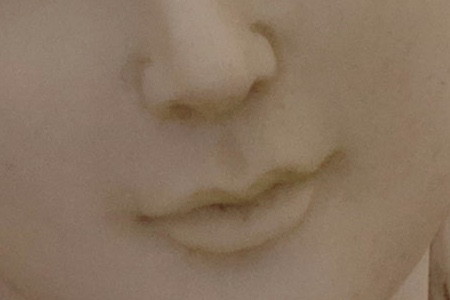
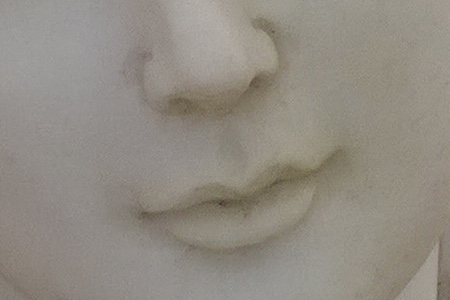
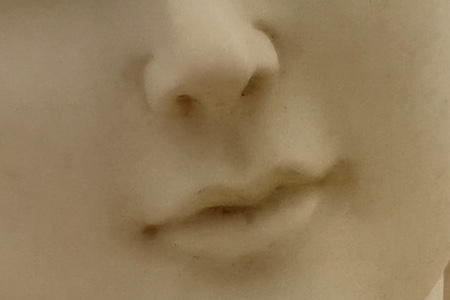

Again, bear in mind that I was using fill-in flash here, which is why they all came out pretty well despite the face being almost in silhouette, technically. I only went to 4x zoom on the K Zoom because 10x would have been stupid at this range. In fact, even fill-in flash from the K Zoom's extra large Xenon unit was overkill and the photo was a bit over-white as a result. Of the three main contenders here, I'm happiest with the Lumia 1020's result in terms of detail and colour, while the 808's didn't quite get the lighting and dynamics right, and the S9+ had to do everything with available light, having no Xenon to fill-in.
Test 5: Indoor detail
Inside my local church, there's good lighting, but still way below what's available outside. Here's the overall unzoomed scene:

You can grab the original test images from the Nokia 808, Nokia Lumia 1020, Samsung Galaxy S9+ and Galaxy K Zoom here, if you want to download them and do your own analysis.
And here are the promised detailed 1:1 crops from the zoomed shots, in sequence from 5MP at 2.5x zoom for the two Nokias (the top row), to 9MP at 2x zoom for the Galaxy S9+ and 10x for the K Zoom (the bottom row):
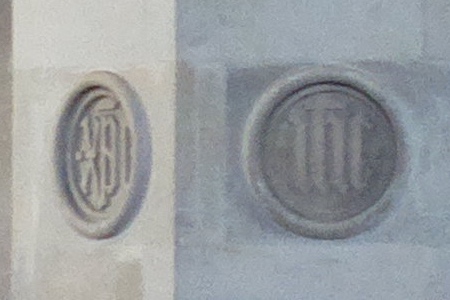
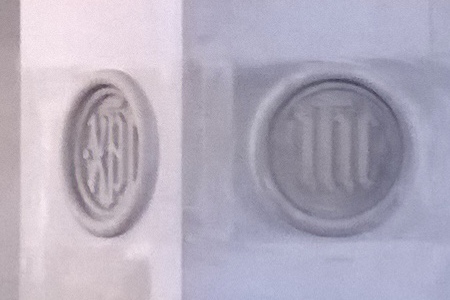
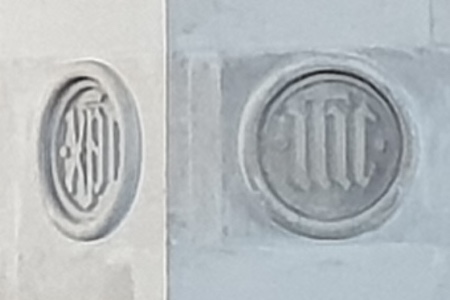
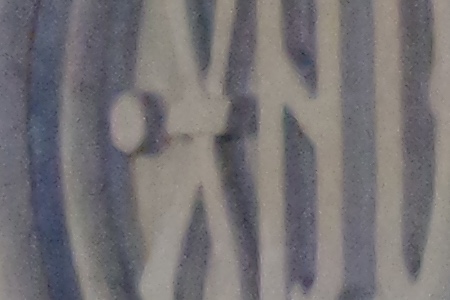
Now here's where things get interesting, in that we start dealing with software more. The Galaxy S9+ telephoto camera can't be used when indoors or in low light - which is to say that it still works, but the limited aperture makes it as noisy as, well, the Nokia 808's zoomed shot. So the S9+ switches to its large aperture (f/1.5) lens and does interpolative zoom, i.e. making up the detail between actual data points - and doing it rather well. Looking at the 808's and S9+'s crops above, the 808 has more real detail but the S9+'s shot somehow looks clearer. While the Lumia 1020's photo is better again, thanks to the OIS keeping the zoom crystal steady throughout the exposure. And the K Zoom's result is massively zoomed - and steady - but also noisy due to the small aperture forced by the optical zoom mechanism.
Test 6: Night time
My standard night time test. Zooming at night means no PureView oversampling to help on the two Nokias, so this might get ugly. And it means no telephoto lens on the S9+, so it's interpolative zoom again on the f/1.5 lens. While even the mighty K Zoom struggles when you zoom in, thanks to the tiny amount of light then being let in. So I limited this to 2x, matching the others. Here's the overall unzoomed scene:

You can grab the original test images from the Nokia 808, Nokia Lumia 1020, Samsung Galaxy S9+ and Galaxy K Zoom here, if you want to download them and do your own analysis.
And here are the promised detailed 1:1 crops from the zoomed shots, in sequence from 5MP at 2.5x zoom for the two Nokias (the top row), to 9MP at 2x zoom for the Galaxy S9+ and (here) also 2x for the K Zoom (the bottom row):
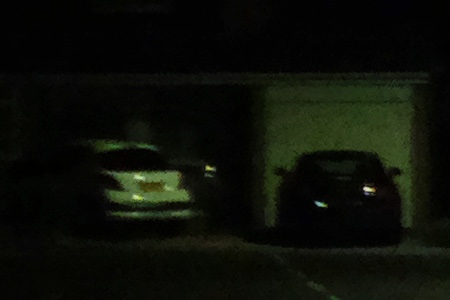

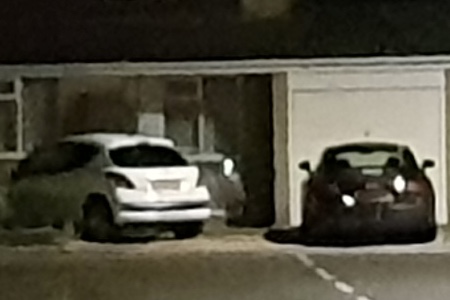
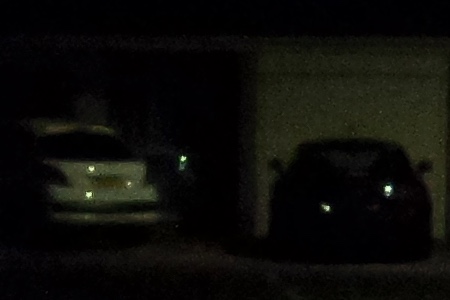
It's not often that a phone camera beats the PureView pair in my night tests, but just look at what that f/1.5 lens pulls out on the S9+ above. With, in theory, only half the resolution to work with, too. A combination of more light and intelligent zoom algorithms. Meanwhile, the Nokia 808 PureView's shot is surprisingly crisp considering that it doesn't have OIS and I wasn't using a tripod for its 1/8s exposure. The Lumia 1020 goes up to 1/3s with its ball-bearing OIS, but there's still not really enough light getting in. And the K Zoom falls down again due to the small aperture in the mechanical zoom lens.
Conclusions
You'll notice that I haven't ascribed scores as I've gone along, for once. Three of these smartphones are now obsolete, so it's not so much a competition as a set of data points. My conclusions:
- The K Zoom's mechanical 10x zoom lens is incredible in all but bad light - and shows that this would have been a viable way to go. But the phone market moves to thinner and thinner form factors, plus dust had a habit of getting into the zoom lens mechanism, so the design wasn't that reliable.
- The Nokia 808 PureView still produces wonderful 'natural' images in most light conditions, free of artefacts and ready for post processing.
- The new Galaxy S9+'s photos and 2x zoom produce excellent results across the board, but Samsung has GOT to dial down its image sharpening in future updates.
- The Lumia 1020 is probably my favourite overall from this feature, with consistently good balance of actual and sharpened detail, allied to genuinely lossless zoom. And, hey the 1020 can still be used as a phone today, with 2018 service, with only a few caveats. I'm just saying...
PS. Of course, the Huawei P20 Pro, announced recently, is another modern contender, using some PureView elements (thanks to input from ex-Nokian Eero Salmelin) to create a hybrid 5x zoom - I'll report back when I have this in for review.
